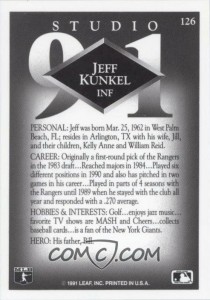The Card
What I like most about this card is Manny’s unusual uniform. It’s certainly not a traditional high school logo with a threatening logo or team name. “Youth Service League” sounds so benign. Turns out that Manny played baseball for New York’s inner city Youth Service League for 5 years while in school.
Topps was the only company to put high school stats on the backs of cards when players had no professional experience. I always thought those numbers were pretty neat.
As with many sets of the time, 1992 Topps was heavy in graphic elements to the point of obscuring the player. Lines, boxes, and colors surround the photo and made it really obvious that your card was off-centered and, therefore, worth less.
Around this time, Topps replaced its traditional stock that looked and felt like recycled cardboard with a firmer, whiter cardstock. Perhaps they took a cue from Upper Deck, the competitor establishing itself as the more upscale brand for collectors.
The Player
Sure, his high school statistics didn’t mean a whole lot, but Manny’s numbers were the best I’d ever seen. Those high school stats led this rookie sabermetrician to believe that Manny would a future star. After glancing at this card and carefully placing it into a rigid plastic sleeve, I was an instant fan.
Manny came up as a promising hitting prospect with the Indians and proceeded to put up steroid-assisted numbers and win steroid-assisted awards with a variety of teams.
He eventually became every bit the hitter I thought he’d be, his gaudy RBI numbers helped somewhat by playing on teams with solid hitters in the lineup around him. He had an extended peak from ages 27 to 30 with the Indians and Red Sox, but he remained one of the league’s best hitters until his late 30’s. Steroids probably prevented what should have been a gradual decline in his abilities. He was on the Mitchell Report in 2003 at age 31 and busted by MLB in 2009 and again in 2011.
Manny got repeatedly busted for steroids, retired and came back multiple times on a whim, alienated his teammates, his fans, and the press. He was also arrested on charges of misdemeanor battery of his wife.
Somehow, for Manny, it was OK taking a giant shit on the game of baseball and everyone around him for his entire career. To the inexplicably tolerant public, his hijinks were endearing. He was simply “Manny Being Manny”. I honestly don’t know how everybody didn’t turn on him and drum him out of the game. In a final act of irrational adoration, he will be inducted into the Hall of Fame.
At age 41, Manny batted .259 with AAA Round Rock, trying desperately to make it back to the majors and make a few more bucks before he lost his abilities for good. He was cut mid-season. Let’s hope he doesn’t try to come back again. We’ve seen enough.







